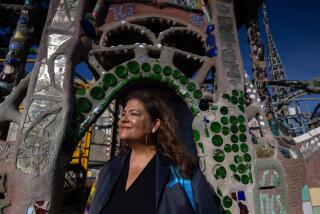Fears for Security All But Push Public’s Art Out of Public View : Washington: Many federal buildings are themselves treasures of art and architecture. Murals both stark and ennobling adorn walls and ceilings, but the days when people could stroll in are gone.
- Share via
WASHINGTON — One night 10 years ago, a contractor was ripping out a wall at the Treasury Department when iron bearings the size of large marbles began spilling onto the floor.
He had come upon a hidden treasure--a vault forgotten for more than 70 years. Upstairs, ceiling murals were found under 15 layers of paint. Q-Tip by Q-Tip, they re-emerged.
Many federal buildings in Washington, off the well-trodden tourist path, are themselves hidden treasures of art and architecture, filled with swanky, colorful or historic spaces where government works away from the public eye.
Murals both stark and ennobling adorn walls and ceilings, creations of a democratic ethic that favored fixed surfaces over movable canvasses because the rich and powerful could never take the art away from the people.
Instead, to a large extent, the people have been taken away from the art.
Gone are the days when people could stroll the hallways. Now people need an appointment, an escort, a pass--a reason. Modern security stands like a wall blocking the public’s art from the public’s view.
From the Justice Department, a jewel of Art Deco design graced with New Deal murals; to Treasury, a showcase of Victorian and Renaissance Revival styles, these spaces can be seen with planning and a bit of luck--and usually with a photo ID.
Many of these buildings are ignored by the tourist books. Typically, a few thousand people a year find their way in, while the State Department, with regular tours, gets 100,000.
A year ago, the Justice Department responded to Atty. Gen. Janet Reno’s desire for more public access and started irregular tours on request, when volunteer guides could fit them in.
“This is refreshing,” said Virginia Mecklenburg of the National Museum of American Art. “There’s a . . . recognition that they have an important part of our national patrimony there.”
America’s foremost Depression-era artists brought federal buildings alive with painting and sculpture that survive in various states of repair.
The General Services Administration, which looks after most federal buildings, began a 10-year art-conservation program in 1990. No one knows yet how that will fare in the $1.4 billion in proposed GSA budget cuts.
The Old Post Office glorified the labors of mail carriers from the arctic to the tropics in murals that now show wear and the occasional tear.
Leading Native American and white artists of the 1930s turned Interior’s walls into a celebration of native culture and Western expansion. Some murals have been conserved; others are chipped, gouged or faded and are slowly being brought back to life.
“There was a great deal of ignorance--still is,” said Interior museum specialist Kim Robinson, standing in the closed-off penthouse where some murals were covered with wall paint and others seem hopelessly flaked.
Art from the old Social Security building marks the system’s achievements, including “Reconstruction and the Well-Being of the Family.”
Justice murals, some inspired by Mexican socialist painters, portray human degradation and promise, often in the same piece.
Some leftist artists tried to sneak Karl Marx into their work, experts say. But at Treasury, all walnut and marble and capitalist power, Marx is not in sight. Here the U.S. insignia is rendered as a dollar sign and sculpted gold coins spill out of cornucopias.
“Very literal symbolism,” Treasury curator Paula Mohr said with a smile.
Fancy moldings, wall patterns, spiral stairways, curtains and more have come back, thanks to $2.3 million in private restoration since 1985.
The rediscovered vault is a wall of plates with iron balls sandwiched in sockets between them. The bearings were designed to spin rather than yield to a culprit’s drill.
At the GSA, spokesman Steve Guiheen recalled that when he came there in the 1970s, the “building was wide open. No guards, no IDs, nothing. It was one of the last to put a zipper on it.”
Now, in large measure, the art is mostly for government workers to see.
If feeling frustrated, they can look up at murals in the Justice library. One shows a clock in the form of a spider web, with an animal skull caught in it and Oliver Wendell Holmes on a white horse, as Don Quixote.
More to Read
Sign up for The Wild
We’ll help you find the best places to hike, bike and run, as well as the perfect silent spots for meditation and yoga.
You may occasionally receive promotional content from the Los Angeles Times.






